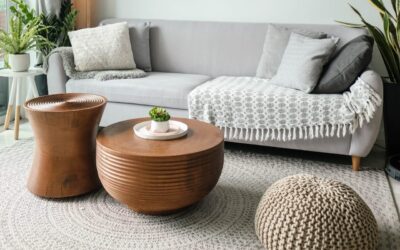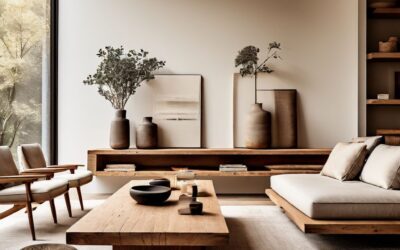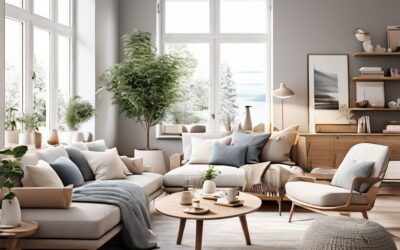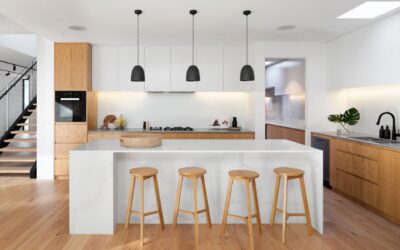The Craftsman style of interior design brings to mind cozy, welcoming spaces featuring natural materials, clean lines, and a connection to nature. This iconic style has its roots in the Arts & Crafts movement of the late 19th and early 20th centuries, which emphasized quality craftsmanship and rejected mass production. The Craftsman aesthetic remains popular today, offering a warm and inviting look for modern homes. In this blog post, we’ll explore the history, elements, and best practices for achieving the Craftsman style.
The Craftsman style emerged most prominently in architecture and furnishings from approximately 1905 to 1930. It was influenced by the English Arts & Crafts movement and Japanese architecture and design. The style is most closely associated with the architecture of Greene and Greene, Charles Sumner Greene and Henry Mather Greene, who designed many Craftsman homes primarily in California. Their designs featured exposed beams, natural wood finishes, built-in furnishings, oversized fireplaces made of stone, and integration with the outdoors.
What is Craftsman Interior Design?
Craftsman interior design emphasizes simplicity, quality, and natural materials. It creates a cozy, lived-in look that embraces imperfections and celebrates craftsmanship. Key elements of the Craftsman aesthetic include:
- Exposed wood beams, trim, and cabinetry made of rich hardwoods like oak or maple
- Stone elements like fireplaces, exposed chimneys, and accent walls
- Natural finishes like stained wood, limewashed walls, and plaster
- Built-in cabinetry, benches, and shelving
- Arts & Crafts-inspired lighting fixtures
- Handcrafted pottery, furniture, and textiles
- Neutral color schemes accented with shades of green, brown, and red
- Connection to the outdoors through porches, oversized windows, and natural light
The overall look is both rustic and refined, combining rugged, raw materials with an emphasis on fine craftsmanship and clean lines.
History of Craftsman Style
The Craftsman style was an offshoot of the late 19th century Arts & Crafts movement, which originated in England as a reaction to the poor quality of mass-produced goods and the working conditions in factories during the Industrial Revolution. Leaders of the movement like William Morris advocated for handmade goods, quality materials, and a return to medieval craft guild traditions.
The aesthetics and philosophy of the Arts & Crafts movement made their way to America in the late 19th century. In California, brothers Charles Sumner Greene and Henry Mather Greene began designing simple but elegant Craftsman homes, often accompanied by detailed wood and stonework. Their emphasis on nature, handcrafted goods, and simplicity revolutionized architecture and interior design.
The magazines The Craftsman, Gustav Stickley’s The Craftsman, and Ladies’ Home Journal helped popularize the style across America. Craftsman homes and furnishings became a hallmark of the American Arts & Crafts movement from around 1905 through the 1920s. At its peak, Craftsman design was promoted as an affordable and livable style for average middle-class families.
After the 1920s, the minimalist tenets of Modernism replaced Craftsman as the dominant architectural style. But Craftsman homes remain iconic today, and Craftsman style furnishings and accents continue to offer an inviting, livable aesthetic option for interior design.
Characteristics/Elements of Craftsman Style
- Natural materials like stone, wood, plaster, and metal
- Visible construction techniques like exposed beams and joints
- Built-in shelves, benches, and furniture
- Simple, sturdy lines
- Handcrafted pottery, rugs, and textiles
- Very little ornamentation outside of hardware and lighting
- Oversize fireplaces made of stone
- Deep porches with chunky columns and railings
- Lots of windows and light, often with stained glass accents
- Neutral color schemes accented with deep greens, browns, and reds
- Connection to nature through materials and ample sunlight
- Imperfections like visible nails, rough edges, and irregularities
How to Achieve the Craftsman Look
Here are some key ways to incorporate Craftsman style into a modern interior:
Focus on natural materials: Use real wood for exposed beams, built-in shelves, hardwood flooring, and cabinetry. Incorporate stone elements like chunky fireplace mantels, accent walls, or tile backsplashes. Plaster or limewash walls for texture over drywall. Look for wool rugs and cotton upholstery.
Add built-in cabinetry and benches: Built-ins help maximize space while looking like original elements of the home. Add built-in window seats, bookshelves, dining benches, and cabinetry. Opt for simple Shaker-style doors and drawers.
Choose Arts & Crafts-inspired lighting: Look for lighting with a handcrafted feel, like pendant lights with visible hammered metal or wood accents. Tiffany-style glass lamps add color. Add lanterns and sconces for ambient lighting.
Include natural greenery: Potted plants, fresh flowers, and wreaths represent Craftsman style’s connection to nature. Add an indoor garden or atrium if possible. Display greenery in built-in shelves and window boxes.
Use richly stained wood tones: Look for oak or maple cabinets, furniture, and floors stained in deep brown, red, or greenish-gray tones. Avoid painted pieces for the most authentic look. Soften shiny varnish with a natural beeswax finish.
Add handcrafted accents: Search Etsy or local craft fairs for pottery, ceramic tiles, woven blankets, and wood carvings to display. Handmade accents reinforce the importance of craftsmanship.
Design an oversized stone fireplace: A chunky fireplace from natural materials like stone or brick is the ultimate Craftsman anchor. Extend the mantel to the ceiling for drama. Add built-in shelving and bench seating alongside.
Include artisan tile accents: Handmade ceramic tile in natural green, brown, and ochre hues adds color and texture as a backsplash, shower surround, or floor inlay. Opt for an imperfect, artsy look.
Use restrained colors: Stick to neutral walls and natural fabrics in creamy whites, warm grays, denim blues, forest greens, and earthy browns. Add accents of terracotta, mossy green, gold, or burnt orange for personality.
Connect indoor and outdoor spaces: Mimic the classic Craftsman porches and ample daylighting. Open floor plans improve flow. Add a comfy window seat or built-in bench by garden-view windows. Display outdoor greenery just inside.
Leave some imperfections: Don’t hide all nails, screws, seams, dents, or scratches. Celebrate evidence of handcraftsmanship to embrace authenticity.
Best Practices for Craftsman Style
To nail the Craftsman aesthetic, keep these best practices in mind:
- Choose quality over quantity for furniture and accessories. Source antiques and handmade goods over mass-produced items when possible.
- Work with skilled craftspeople for built-ins, tilework, lighting, and specialty pieces whenever it fits your budget.
- Prioritize natural light with ample windows, skylights, and minimal window treatments. Add window seats and built-in shelving below windows.
- Create an open, connected feel between rooms. Limit ornate trim and crown molding for a simpler look.
- Incorporate natural greenery like large potted plants. Herbs, succulents, and ferns complement Craftsman style.
- Add texture with exposed beams, reclaimed wood, natural stone, plaster walls, wool rugs, and woven textiles.
- Look for antique or vintage hardware like cast iron hinges and knobs. Oil-rubbed bronze has an aged patina that fits Craftsman style.
- Small touches like woven baskets, ceramics, and woodcarvings make great authentic accents. Display collections meaningfully.
- Mix metal finishes like unlacquered brass, oil-rubbed bronze, wrought iron, and nickel for depth. Avoid polished chrome.
- Warm up modern conveniences like overhead lighting and HVAC grates by pairing them with vintage-style fixtures and period-appropriate registers.
- Imperfections show off craftsmanship. Avoid covering upsmall irregularities and embrace signs of wear as patina.
Conclusion
The Craftsman style offers a livable, unfussy aesthetic that celebrates natural materials, quality craftsmanship, and connection to the outdoors. Its origins in the Arts & Crafts movement make it an iconic part of design history, but Craftsman elements still feel fresh and current. By focusing on handcrafted goods, simple lines, and rich natural textures, you can achieve a cozy and inviting Craftsman interior with broad appeal. Visible care in construction along with meaningful, well-curated accessories will make the space truly refreshing. Does the Craftsman aesthetic speak to you? Let raw materials and rustic refinement transform your interior into a comfortable, modern retreat.













